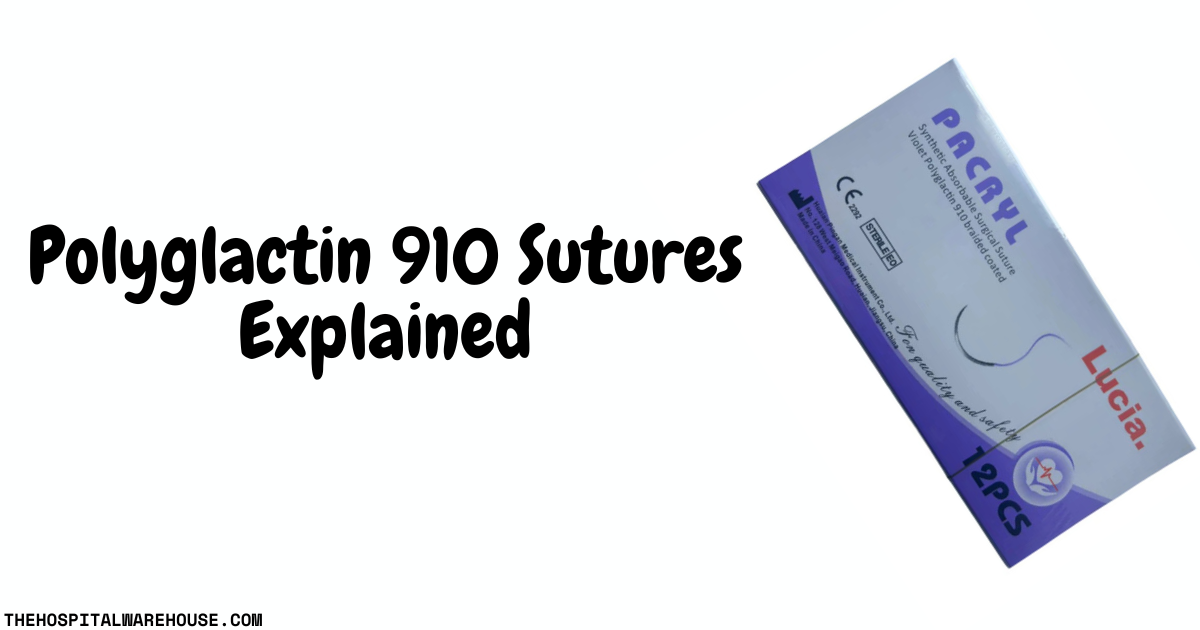
Polyglactin 910 Sutures Explained: Uses, Benefits, and Absorption Time
When it comes to surgical procedures, choosing the right suture material can make all the difference in patient outcomes. If you're a medical professional working in Kenya's healthcare system, you've likely encountered Polyglactin 910 sutures countless times. But what exactly makes these sutures so popular in Kenyan hospitals, and why do surgeons trust them for critical procedures?
In this comprehensive guide, we'll break down everything you need to know about Polyglactin 910 sutures, from their unique composition to their absorption timeline, and explore why they've become a staple in medical facilities across Kenya.
What are Polyglactin 910 Sutures?
Polyglactin 910 sutures are synthetic, absorbable surgical sutures made from a carefully engineered co-polymer of glycolide and lactide. Think of them as the reliable workhorses of the suture world, they're designed to do their job effectively and then safely disappear from the body without requiring removal.
Unlike traditional silk or cotton sutures that need to be manually removed, Polyglactin 910 sutures are completely absorbed by the body's natural processes. This synthetic composition gives them a significant advantage over natural absorbable sutures like catgut, offering more predictable performance and reduced risk of allergic reactions.
The "910" designation refers to the specific ratio of glycolide to lactide in the polymer chain, which has been optimized to provide the ideal balance of strength, handling characteristics, and absorption rate for most surgical applications.
Key Benefits of Polyglactin Sutures
Strong Initial Tensile Strength
One of the standout features of Polyglactin 910 sutures is their impressive initial strength. When a surgeon places these sutures, they can count on them to hold tissues securely during the critical early healing phase. This strength is particularly important in procedures where wound tension is high or where patient movement might stress the suture line.
Predictable Absorption Timeline
Unlike some absorbable sutures that can be unpredictable, Polyglactin 910 sutures offer reliable absorption over 60–90 days. This predictability allows surgeons to plan post-operative care with confidence, knowing exactly when the sutures will lose their strength and when complete absorption will occur.
Minimal Tissue Reaction
Perhaps one of the most valuable characteristics of these sutures is their biocompatibility. They cause minimal inflammatory response in tissues, making them ideal for delicate procedures where excessive scarring or tissue reaction could compromise outcomes. This is particularly beneficial in cosmetic surgeries, pediatric procedures, and operations involving sensitive organs.
Absorption Time Explained
Understanding the absorption timeline of Polyglactin 910 sutures is crucial for proper surgical planning and patient care. Here's what happens over time:
Days 1-14: The sutures maintain approximately 75% of their original tensile strength, providing robust wound support during the initial healing phase.
Days 14-21: Strength begins to decrease more rapidly as the absorption process accelerates, dropping to about 50% of original strength.
Days 21-42: Sutures continue to weaken but still provide some structural support as tissues gain strength.
Days 60-90: Complete absorption occurs, with the suture material fully broken down into water and carbon dioxide.
Factors Affecting Absorption Rate
Several factors can influence how quickly Polyglactin 910 sutures are absorbed:
Patient Health: Patients with compromised immune systems, diabetes, or poor nutrition may experience slower absorption rates. Conversely, younger, healthier patients typically see faster absorption.
Wound Environment: Areas with good blood supply absorb sutures more quickly than poorly vascularized tissues. Infected or inflamed tissues may also affect absorption rates.
Suture Size: Larger diameter sutures naturally take longer to absorb completely compared to finer sutures.
Common Medical Uses in Kenya
General Surgery
In Kenya's busy general surgery departments, Polyglactin 910 sutures are frequently used for closing muscle layers, subcutaneous tissues, and internal organs. Their reliability makes them particularly valuable in emergency surgeries where surgeons need dependable materials under pressure.
Gynecology & Obstetrics
These sutures have become indispensable in gynecological procedures and cesarean sections. Their gentle tissue reaction makes them ideal for reproductive surgeries where minimizing scarring is important for future pregnancies and overall patient comfort.
Gastrointestinal Procedures
For bowel surgeries and other GI procedures, the biocompatibility of Polyglactin 910 sutures reduces the risk of complications. Surgeons appreciate their consistent performance in an environment where healing can be challenging due to bacterial presence and digestive enzymes.
Pediatric Surgeries
When operating on children, the gentle nature of these sutures becomes even more critical. Young patients heal differently than adults, and the minimal tissue reaction of Polyglactin 910 sutures supports better cosmetic outcomes and reduces long-term complications.
Why Hospitals in Kenya Prefer Polyglactin 910
Cost-Effectiveness
In Kenya's healthcare landscape, where budget considerations often influence medical decisions, Polyglactin 910 sutures offer excellent value. They provide premium performance at a reasonable cost, especially when purchased in bulk quantities. This cost-effectiveness doesn't come at the expense of quality – these sutures meet international standards while remaining accessible to healthcare facilities with varying budgets.
Reliable Healing Outcomes
Kenyan surgeons have built trust in Polyglactin 910 sutures through years of consistent results. The predictable absorption timeline means fewer post-operative complications and reduced need for follow-up procedures to remove sutures. This reliability is particularly important in rural hospitals where patient follow-up can be challenging.
Reduced Training Requirements
Because these sutures handle similarly to non-absorbable sutures but don't require removal, they simplify post-operative care protocols. This is especially valuable in facilities where nursing staff may have varying levels of experience with different suture types.
Best Practices for Using Polyglactin 910 Sutures
To get the most out of these sutures, consider these practical tips:
Storage: Keep sutures in a cool, dry place away from direct sunlight. Proper storage ensures optimal performance and extends shelf life.
Handling: While Polyglactin 910 sutures are robust, gentle handling during surgery prevents unnecessary weakening of the material.
Patient Education: Inform patients about the absorption timeline so they understand what to expect during recovery and don't worry unnecessarily about suture dissolution.
The Future of Absorbable Sutures in Kenya
As Kenya's healthcare system continues to evolve and modernize, the demand for reliable, cost-effective medical supplies like Polyglactin 910 sutures will only grow. These sutures represent the perfect balance of advanced medical technology and practical healthcare economics that Kenya's medical community needs.
The consistent performance and proven track record of Polyglactin 910 sutures make them an excellent choice for healthcare facilities looking to improve patient outcomes while managing costs effectively. Whether you're running a large urban hospital or a smaller rural clinic, these sutures can help you deliver quality care to your patients.
Looking for reliable Polyglactin 910 sutures in Kenya? At The Hospital Warehouse, we stock high-quality sutures and offer discounts on bulk orders for hospitals and clinics. Our commitment to supporting Kenya's healthcare providers means competitive pricing, reliable supply chains, and the medical supplies you need when you need them.
Contact us today to learn more about our bulk pricing options and ensure your facility is always stocked with the sutures your surgical teams depend on.

Leave a comment